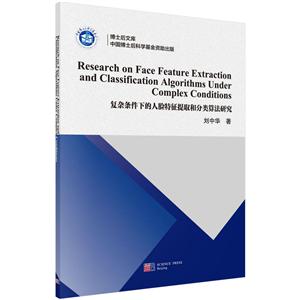-
>
全国计算机等级考试最新真考题库模拟考场及详解·二级MSOffice高级应用
-
>
决战行测5000题(言语理解与表达)
-
>
软件性能测试.分析与调优实践之路
-
>
第一行代码Android
-
>
JAVA持续交付
-
>
EXCEL最强教科书(完全版)(全彩印刷)
-
>
深度学习
博士后文库复杂条件下的人脸特征提取和分类研究(英文版) 版权信息
- ISBN:9787030549501
- 条形码:9787030549501 ; 978-7-03-054950-1
- 装帧:一般胶版纸
- 册数:暂无
- 重量:暂无
- 所属分类:>
博士后文库复杂条件下的人脸特征提取和分类研究(英文版) 本书特色
Asmotivatedbytheextensivepotentialapplicationsinpublicsecurity,financialsecurity,human-computerinteraction,biometricsrecognitionespeciallyfacerecognitionhasbecomeoneofthehottopicsinthefieldsofpatternrecognitionandartificialintelligence.Thisbookmainlyfocusesonfeatureextractionandclassificationalgorithmsundercomplexconditions,anditsobjectiveisthatthereaderscanquicklyunderstandthelatestfeatureextractionandclassificationmethods.Themaincontentsofthebookareasfollows:imagesynthesisandclassificationmethodbasedonquotientimagetheory;aclassificationmethodbasedonreconstructionerrorandnormalizeddistance;facerecognitionmethodbasedontheoriginalandapproximatefaceimages;enhancedcollaborativerepresentationbasedclassification;approximateandcompetitiverepresentationmethod;akerneltwo-phasetestsamplesparserepresentationmethod;quaternion-basedmaximummargincriterionmethod.《BR》 Thisbookcanbeusedforpostgraduatesandseniorundergraduatesmajoredincontrolscienceandengineering.Meanwhile,itisalsoaquiteusefulreferencebookfortheresearchersintherelatedfields.
博士后文库复杂条件下的人脸特征提取和分类研究(英文版) 内容简介
Asmotivatedbytheextensivepotentialapplicationsinpublicsecurity,finansecurity,human-computerinteraction,biometricsrecognitionespelyfacerecognitionhasbecomeoneofthehottopicsinthefieldsofpatternrecognitionandartifiintelligence.Thisbookmainlyfocusesonfeatureextractionandclassificationalgorithmsundercomplexconditions,anditsobjectiveisthatthereaderscanquicklyunderstandthelatestfeatureextractionandclassificationmethods.Themaincontentsofthebookareasfollows:imagesynthesisandclassificationmethodbasedonquotientimagetheory;aclassificationmethodbasedonreconstructionerrorandnormalizeddistance;facerecognitionmethodbasedontheoriginalandapproximatefaceimages;enhancedcollaborativerepresentationbasedclassification;approximateandcompetitiverepresentationmethod;akerneltwo-phasetestsamplesparserepresentationmethod;quaternion-basedmaximummargincriterionmethod.
Thisbookcanbeusedforpostgraduatesandseniorundergraduatesmajoredincontrolscienceandengineering.Meanwhile,itisalsoaquiteusefulreferencebookfortheresearchersintherelatedfields.
博士后文库复杂条件下的人脸特征提取和分类研究(英文版) 目录
- >
大红狗在马戏团-大红狗克里弗-助人
大红狗在马戏团-大红狗克里弗-助人
¥5.2¥10.0 - >
【精装绘本】画给孩子的中国神话
【精装绘本】画给孩子的中国神话
¥18.6¥55.0 - >
巴金-再思录
巴金-再思录
¥15.7¥46.0 - >
随园食单
随园食单
¥16.4¥48.0 - >
人文阅读与收藏·良友文学丛书:一天的工作
人文阅读与收藏·良友文学丛书:一天的工作
¥15.7¥45.8 - >
李白与唐代文化
李白与唐代文化
¥9.9¥29.8 - >
中国人在乌苏里边疆区:历史与人类学概述
中国人在乌苏里边疆区:历史与人类学概述
¥21.6¥48.0 - >
月亮与六便士
月亮与六便士
¥19.1¥42.0
-
微信背后的产品观
¥62.6¥88 -
副本
¥30.6¥78 -
云计算(第四版)
¥57.3¥88 -
黑客与画家(10万册纪念版)
¥62.9¥99.8 -
不良情绪应急处理包--孤独感
¥12.9¥30 -
不良情绪应急处理包--精神内耗
¥12.9¥30

















